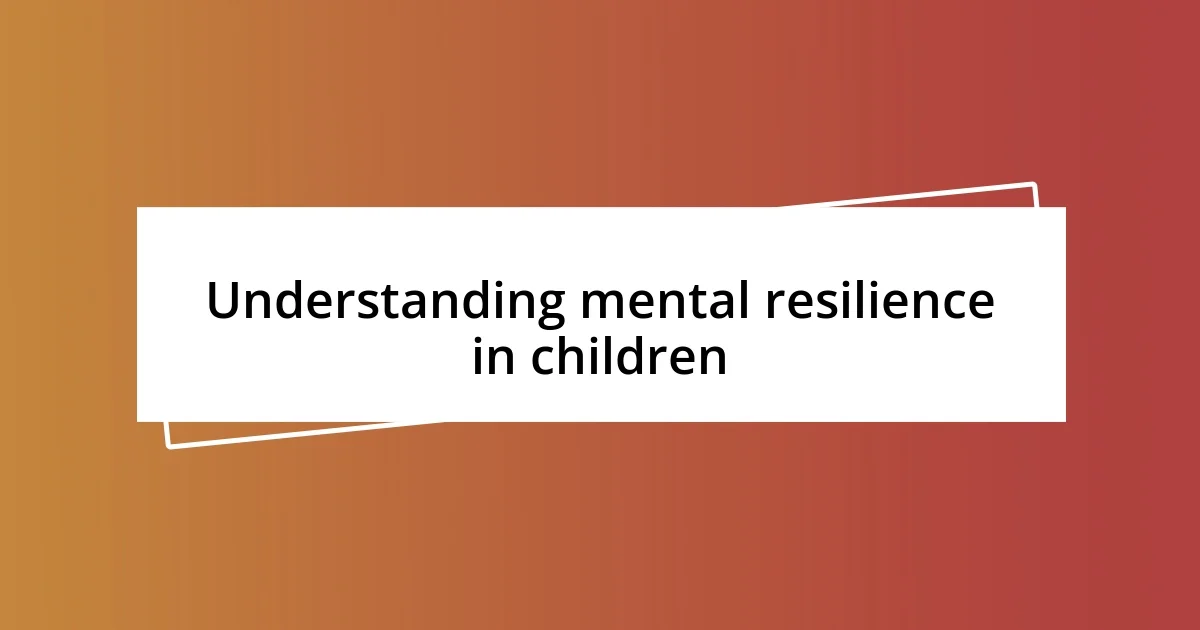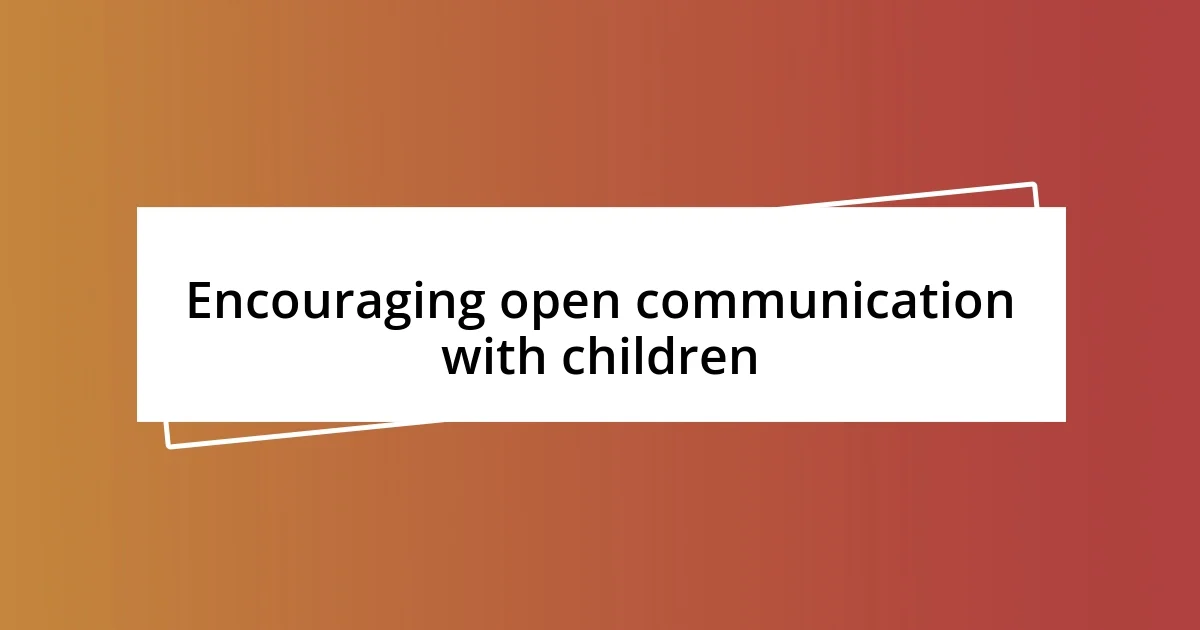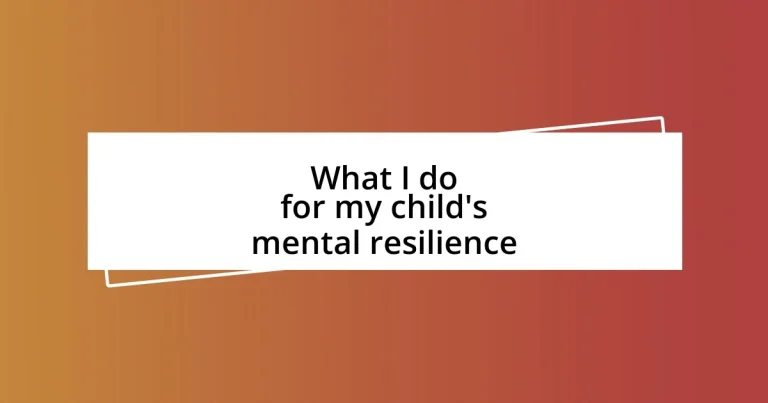Key takeaways:
- Resilience in children is fostered through open conversations about feelings and failures, allowing them to view setbacks as growth opportunities.
- Creating a supportive home environment, with practices like open communication and celebrating efforts, lays a strong foundation for a child’s emotional resilience.
- Monitoring progress and adapting coping strategies is essential, recognizing that different approaches may be needed at different times to support a child’s emotional development.

Understanding mental resilience in children
Understanding mental resilience in children is crucial for their development. I remember when my child faced a tough situation at school, struggling with a project that felt overwhelmingly complex. Witnessing their frustration broke my heart, yet it also opened a door to teach them about perseverance – a key component of resilience.
Resilience isn’t just about bouncing back; it’s about growing through challenges. I often find myself asking, how do we equip our kids to handle adversity? By fostering open conversations about feelings and failures, we empower them to view setbacks as opportunities for growth instead of as barriers.
Seeing my child navigate disappointments has been enlightening. I’ve learned that emotional resilience stems from a supportive environment where children feel safe to express themselves. Every time I reassure my child that it’s okay to fail, I can see a little spark of confidence ignite – it’s as if they begin to understand that resilience is a journey, not just a destination.

Importance of nurturing emotional skills
Nurturing emotional skills is vital for a child’s mental resilience. When I observed my child become upset after losing a game, I understood it was more than just a game to them; it was about learning how to manage disappointment. Rather than simply encouraging them to “try harder next time,” I found it valuable to discuss their feelings, validating their emotions and guiding them through the process of understanding and coping with loss.
In another instance, during a rough patch at school, I noticed my child needed a way to express frustration constructively. We created a “feelings jar” together, where they could write down their emotions and let them out. This simple act became a powerful tool for emotional awareness. It displayed to them that feelings are valid, and recognizing them is the first step towards emotional resilience.
Emotionally skilled children not only learn to cope but thrive in life’s ups and downs. I’ve often reflected on how equipping my child with these skills prepares them for the inevitable challenges ahead. Each conversation about feelings or technique we practice is like building a muscle; the more they use it, the stronger it becomes. It’s truly rewarding to witness my child developing a nuanced understanding of their emotions.
| Nurturing Emotional Skills | Benefits |
|---|---|
| Recognizing and Validating Emotions | Encourages children to express themselves and feel understood. |
| Developing Coping Mechanisms | Equips children with tools to handle adversity effectively. |
| Building Confidence Through Self-Expression | Fosters a belief in their ability to navigate challenges. |

Building a supportive home environment
Creating a supportive home environment is essential in cultivating my child’s mental resilience. The way my home feels can profoundly influence how my child approaches challenges outside of it. I’ve set up spaces for downtime, like a cozy reading corner filled with their favorite books, where they can retreat when the world feels too much. This kind of environment sends a subtle message: it’s okay to step back and recharge, that pacing ourselves through tough times is a strength, not a weakness.
Here are some key elements I focus on for building a supportive environment:
- Open Communication: I encourage my child to share their thoughts and worries without fear of judgment, fostering honesty in our conversations.
- Consistency and Structure: Maintaining a routine helps my child feel secure; knowing what to expect daily brings a sense of stability.
- Celebrating Efforts and Progress: I make it a point to recognize improvements, no matter how small—each win is a step toward resilience.
- Creating a Safe Space for Emotions: I remind my child that all feelings are valid, and it’s okay to express them, whether through talking, drawing, or other creative outlets.
- Quality Family Time: Regular family activities, like game nights or cooking together, cultivate a sense of belonging and support, strengthening our bond.
Each of these practices contributes to an environment rich in support and understanding, building a strong foundation for my child’s resilience. It’s more than just providing comfort; it’s about actively fostering a culture of growth in our home.

Encouraging open communication with children
Encouraging open communication begins with creating a space where my child feels safe expressing themselves. I remember one evening when my child, after a long day at school, simply sat on the couch and looked troubled. Instead of brushing it off, I gently asked, “What’s on your mind?” This opened the door for them to share their worries, and it felt rewarding to see how much lighter they felt after talking.
Listening actively is just as important as encouraging my child to speak. Sometimes, I notice their little hands fidgeting, signaling hesitation to share. In moments like this, I lean closer, maintaining eye contact and nodding to show I’m engaged. It’s fascinating how a simple gesture can make a child feel heard. I often ask reflective questions like, “How did that make you feel?” which not only prompts deeper discussion but also shows them that their feelings are worthy of exploration.
Establishing regular family check-ins has also been beneficial. We set aside time during dinner to share our highs and lows of the day. I can’t express how enlightening it is for my child to hear my experiences and feelings, too. It normalizes discussions about emotions and challenges. When I share a struggle, I see my child’s eyes widen, not out of surprise, but understanding. It’s like a mutual pact—”We are all navigating this life together.” It fosters resilience knowing they’re not alone, and together, we can overcome anything.

Techniques for teaching coping strategies
Teaching my child effective coping strategies has become an integral part of our daily lives. One technique I’ve found particularly useful is role-playing different scenarios. For instance, when my child faced a tough situation with a friend, we acted it out together. This approach not only helped them think through their feelings but also gave them a chance to practice responses without the pressure of the real situation. I often wonder—what better way to prepare them for life’s challenges than to help them navigate through potential scenarios in a safe space?
Another technique that resonates with me is using breathing exercises. After an emotionally charged day, I guide my child through a simple exercise where we take deep breaths together. I remind them that breathing can be a powerful tool, enabling us to hit pause before reacting. This is not just about calming down but is about teaching them the importance of self-regulation. It’s amazing how just a few minutes of focused breathing can shift their mood and sharpen their perspective.
Finding creative outlets has also proven impactful. Recently, I encouraged my child to express feelings through drawing. One evening, they created a colorful image representing their emotions after a tough class. As they explained each element, it struck me how art became a language for feelings they could hardly put into words. I often ask myself, could there be a more profound way to connect with emotions than through a medium that speaks to the heart? This experience taught both of us that coping can take many forms, and sometimes, art holds the key to unlocking deeper understanding.

Activities that promote mental strength
Engaging in physical activities together has been one of my most rewarding strategies for building mental strength. I decided to enroll my child in martial arts classes, which not only teaches discipline but also equips them with confidence. I vividly remember the first belt promotion ceremony we attended; my child’s face lit up with pride as they received their new belt. It was a moment of realization for me—how physical challenges can lead to mental resilience and a sense of accomplishment.
Another nurturing activity that has enriched my child’s mental fortitude is outdoor exploration. On Saturdays, we make it a tradition to hike in nature. I’ve noticed how stepping away from screens and engaging with the natural world sparks a sense of freedom and adventure. During one hike, we stumbled upon a rocky cliff, and instead of turning back, I encouraged my child to climb it with me, fostering a sense of bravery. Moments like this reinforce the idea that pushing boundaries and overcoming fears can translate into greater self-assurance in facing life’s uncertainties.
Additionally, I’ve found that incorporating gratitude practices into our daily routine cultivates a resilient mindset. Each evening, we take turns sharing three things we are grateful for, no matter how small. I’ve seen how this simple act shifts our focus away from challenges and towards positivity. One day, my child shared their gratitude for a kind classmate, which led to a meaningful conversation about compassion and support in tough times. These heartfelt exchanges remind us, especially in the rush of everyday life, to pause and appreciate the little joys that fortify our spirits.

Monitoring progress and adjusting methods
Monitoring progress involves a keen eye for the changes in my child’s reactions and emotions. Recently, I noticed that my child was becoming more open about their feelings after trying various coping strategies. It made me reflect—how can small shifts in communication reveal deeper progress? I began keeping a journal to track not just the techniques we use but also the specific moments when my child demonstrated resilience. This practice helps me understand which methods resonate best with them.
Adjusting our approaches is equally vital. I’ve learned that not every strategy works indefinitely; sometimes, what helped yesterday might not be effective today. For example, while role-playing has worked wonders for us in the past, there are days when my child prefers to talk about their feelings instead of acting them out. I remember a particular instance where we had to switch gears because my child was feeling overwhelmed after a challenging day at school. Recognizing that need for a change was crucial, and it encouraged me to ask, how can flexibility in our methods promote greater mental strength?
Each milestone in this journey deserves celebration, too! I find that acknowledging progress—no matter how small—fuels motivation and reinforces positive behaviors. After monitoring, I often sit down with my child to review what we’ve learned together, celebrating the resilience they’ve shown. During one of our discussions, they expressed gratitude for the breathing exercises, saying, “It’s like I can press a reset button when I need it.” Moments like these not only affirm our efforts but also deepen our connection, reminding me how important it is to open up dialogue about their growth. Isn’t witnessing this evolution one of the most rewarding experiences of parenthood?














